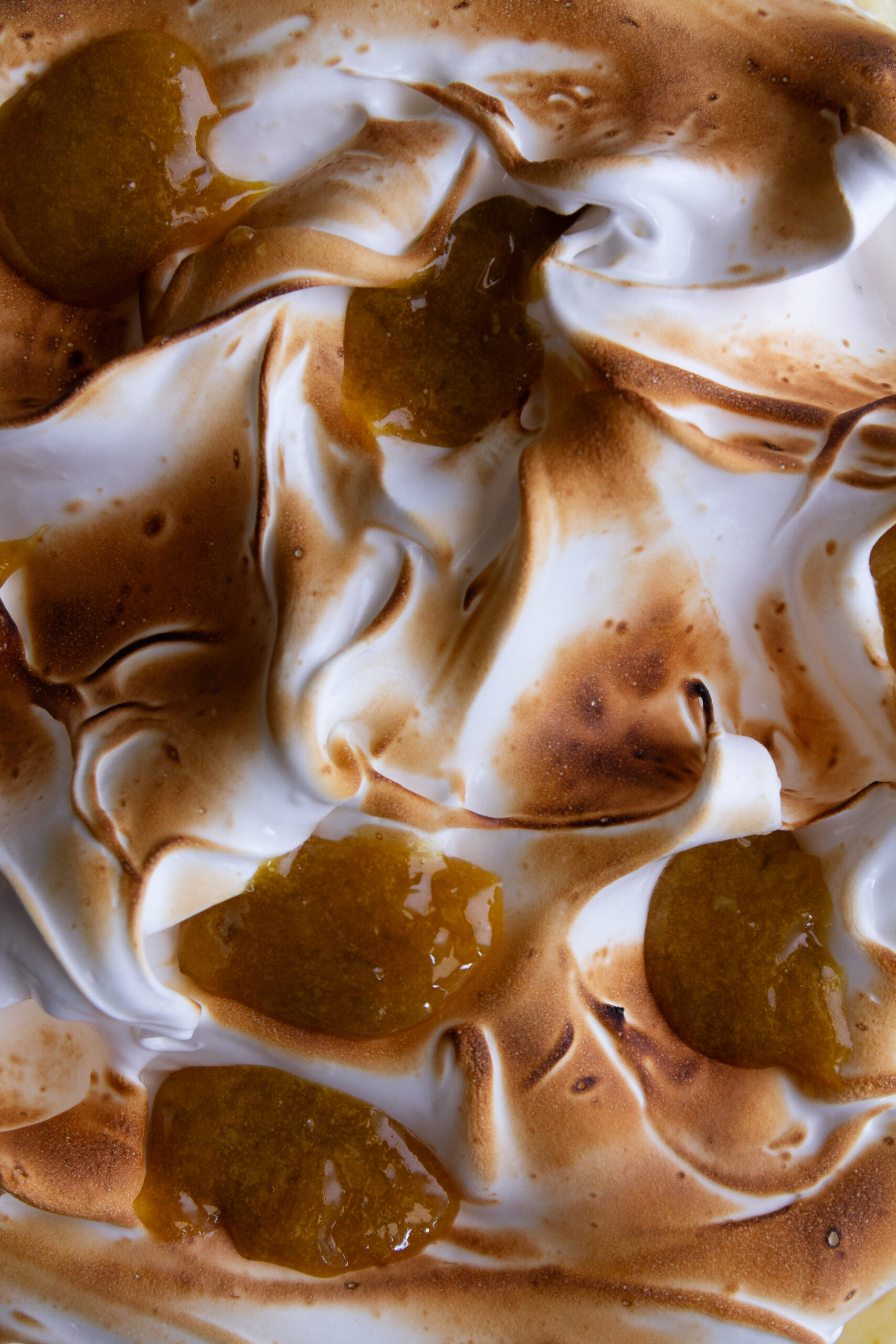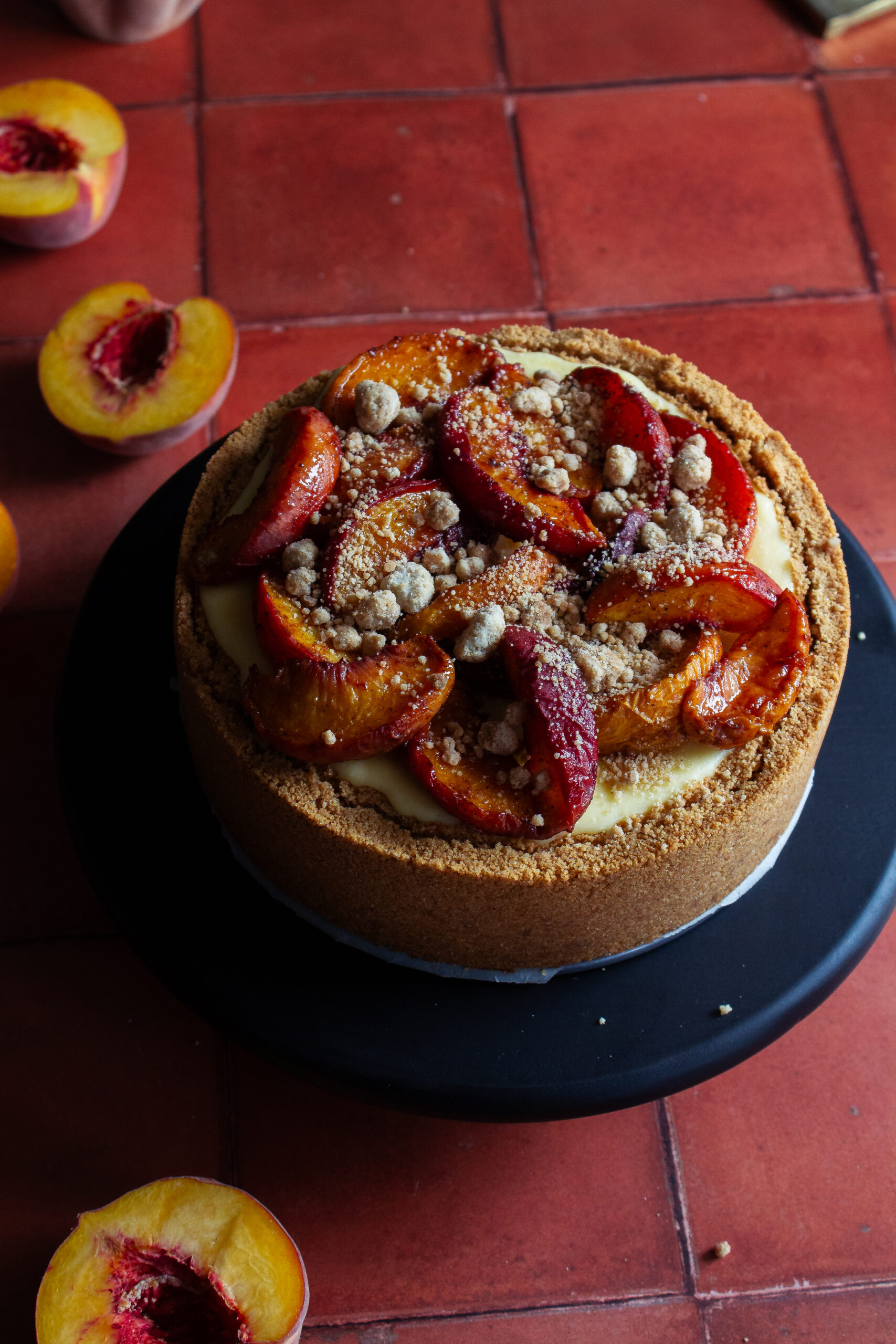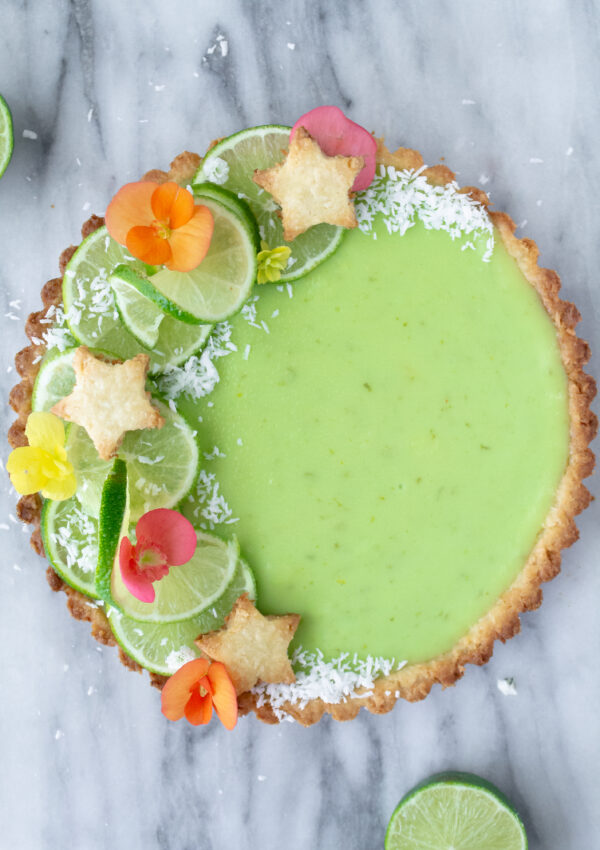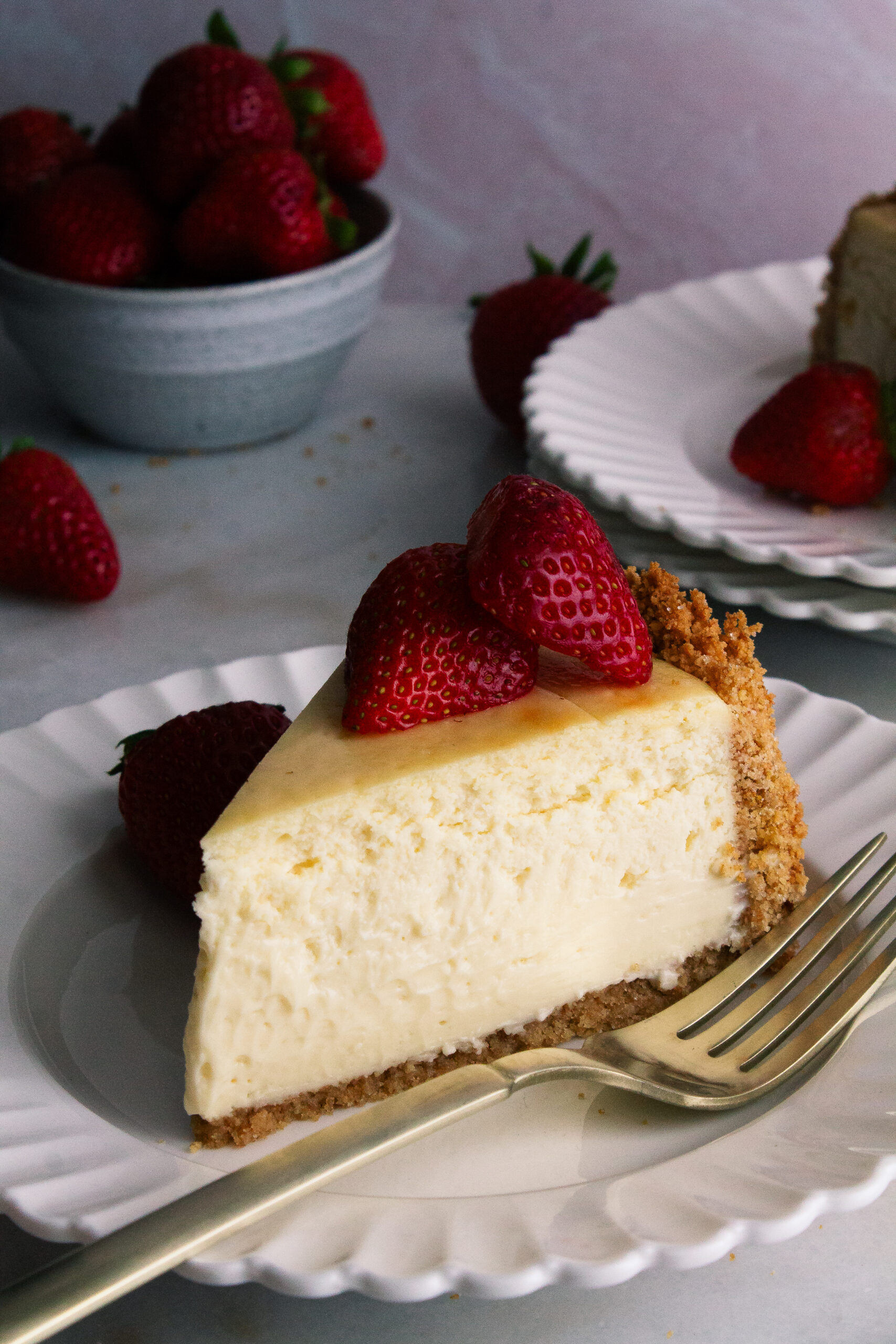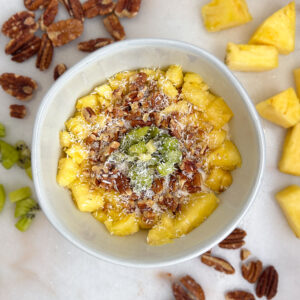This is my Toasted Lime Cheesecake recipe! It’s has a citrus cheesecake base with a biscoff cookie crust. Then it gets topped with a homemade lime curd and meringue that then gets toasted for the best flavor and texture combinations. It’s really a must try recipe. It’s like a cousin of the lemon meringue flavor combination but a bit more punchy and a bit more bold! Follow my instructions in this post for how to make the perfect cheesecake and never struggle with issues like cracked cheesecake tops or underbaked cheesecake again!
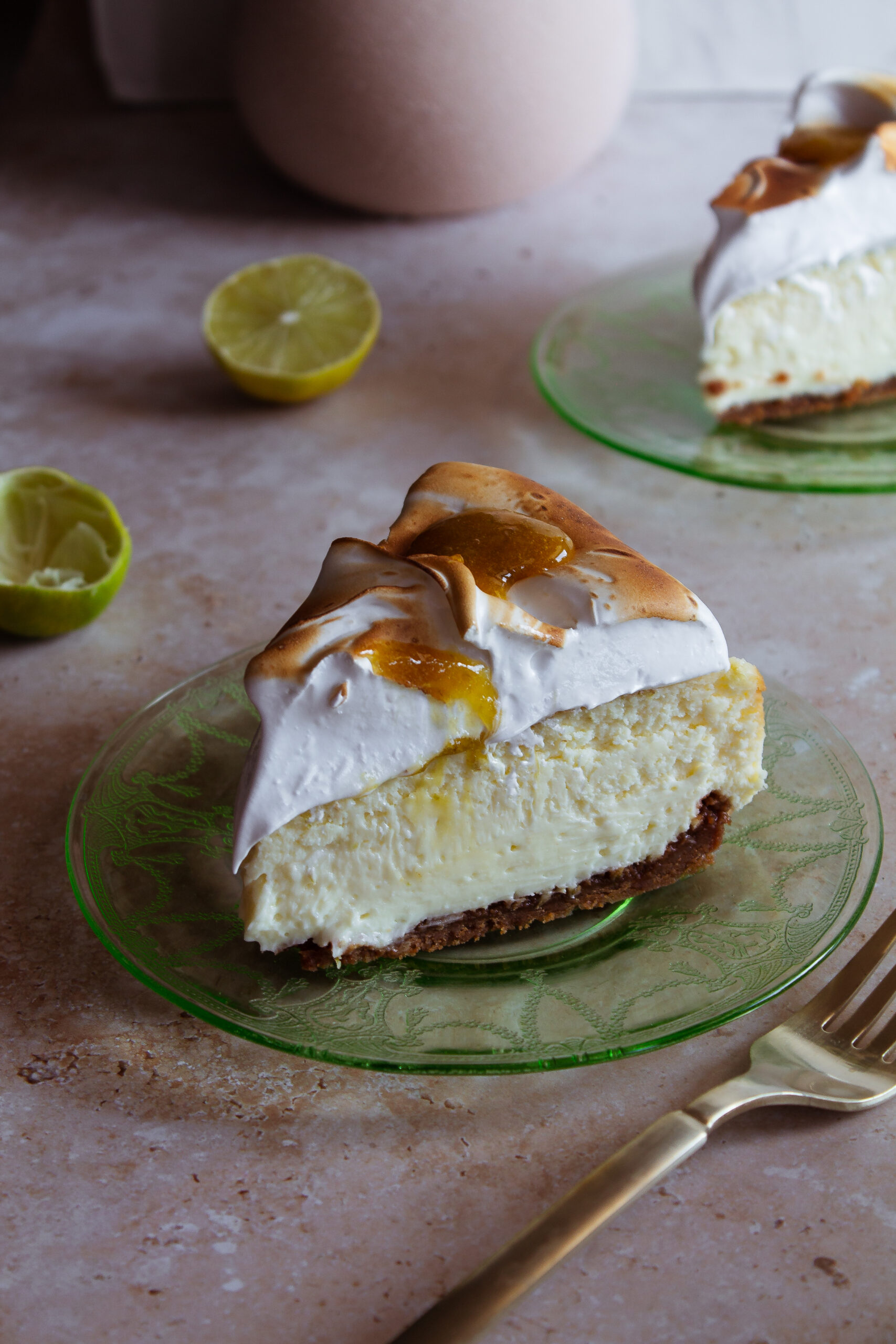
Why this is truly the BEST Toasted Lime Cheesecake Recipe on the internet…
I may be biased, but citrus is one of the best flavors out there. Lemon, lime, orange, grapefruit, give it to me, I am alllll about it! That’s why I think this toasted lime cheesecake is the perfect cheesecake recipe. It marries delicious biscoff cookies with punchy lime and pillowy meringue! You’ll definitely add this to your list of top 10 cheesecake recipes after making it!
How to make Biscoff cookie crust
This biscoff cookie crust pairs so well with the lime in this cheesecake recipe! It comes together so quickly and bakes up like a dream.
The process of making the biscoff cookie crust is very simple:
- Blitz the biscoff cookies into fine crumbs.
- Mix your brown sugar and granulated sugar in with the biscoff cookie crumbs.
- Melt the butter and stir it into the crumb mixture.
- Line the bottom of a 7″ springform pan with parchment paper and add the crust into the pan.
- Press an even layer of the crust onto the bottom of the pan. Press hard to make sure the crust is stuck in place before baking it to set.
- Bake for 8-10 minutes and then allow the biscoff cookie crust to cool before the cheesecake batter gets added.
Top tips for how to make a Toasted Lime Cheesecake
I must admit, for some odd reason I always used to think that making cheesecake was a complicated affair. Then I learned and started putting into practice a few simple cheesecake tips that made the process totally approachable! Once you catch on to the cheesecake learning curve, you’ll be baking them like a total pro!
Tip #1–DO NOT OVERMIX the cheesecake batter! In order to create a classic cheesecake that is rich and creamy it is important to mix the ingredients until they are combined and not much longer. If you beat too much air into the batter you’ll risk it cracking when baked and cooled. Plus, you’ll have a light and airy cheesecake which, there is a time and a place for, it’s just not here! Cracked cheesecake still obviously tastes amazing, but if you’re looking for flawless results, pay attention to this step.
Tip #2–Be sure to use ROOM TEMPERATURE ingredients! I can’t emphasize this enough, in every dessert recipe that calls for room temperature ingredients, listen to it! We don’t call for ingredients to be at room temperature to make your life more complicated. There are many reasons ingredients must truly be at room temperature and one of those reasons is because the ingredients will combine much easier when they’re all at room temp!
Tip #3–Use a CHEAT WATER BATH! Listen folks, I don’t have the time, energy or patience to be fooling with a traditional water bath. Unless it is absolutely necessary for the dessert like maybe a crème brûlée…I’m using my cheat water bath method every time! Simply place a rimmed dish on the bottom rack of the oven and fill it with boiling water. Then bake the cheesecake on the top rack of the oven and you’ll get a lot of the same effects as a water bath. Basically you want the steam from the water to soften the bake, so as long as there is steam, you’re in business!
Tip #4–bake the cheesecake LOW AND SLOW! We bake this cheesecake at 325F for around 50 minutes. One of the characteristics of a classic cheesecake is the mostly pale top. This is one of the ways we achieve that.
How to bake cheesecake step-by-step
While your graham cracker crust is cooling, it’s time to get to work on the cheesecake batter. Pull out those completely room temperature ingredients and let’s get started!
- Set a kettle or a pot of water to boil and set a deep rimmed pan on the bottom rack of the oven.
- Place the cream cheese in a bowl. I actually prefer to use a hand mixer when making cheesecakebecause I find it helps me have more control over how much air I’m adding into the batter.
- Beat the cream cheese slightly to break it out of the block form it came in.
- Add the sugars and cornstarch and beat again until combined, but not for too long as previously mentioned. Overbeating can also lead to cracked cheesecake! We add the cornstarch for a little extra insurance against a cracked cheesecake top.
- Add the eggs one at a time and add the vanilla after the last egg is incorporated and beat until combined.
- Switch to a spatula and add the sour cream. Stir until completely mixed in.
- Add the boiled water to the rimmed pan at the bottom of the oven.
- Pour the cheesecake batter into the cooled graham cracker crust and bake on the rack above the pan of water at 325F for roughly 50 minutes. Remove the cheesecake from the oven when it has a slight wobble.
How to make the lime curd
A lot of curd recipes require that the curd be made in a bain-marie (double boiler). However I find that as long as you pay close attention to the curd, making it over direct heat is perfectly fine.
Start by adding ½ cup of granulated sugar to a small saucepan.
Next, zest your limes until you have 1 Tbsp of lemon zest. I find that 1-2 medium limes work perfectly for both the zest and the juice, but it could be smart to buy two limes just in case. Add the lime zest to the sugar in the saucepan.
Using a whisk, vigorously whisk the sugar and lime zest together in the saucepan. This step helps bring out the oils in the lemon zest, ultimately adding more flavor.
Next, add three egg yolks straight into the saucepan with the sugar and zest and whisk vigorously until the mixture lightens in color.
Pour in ¼ cup of fresh lime juice and whisk until combined.
Place the saucepan over low/medium heat making sure to whisk constantly. Pay special attention to the edges of the saucepan, the curd would most likely burn here if anywhere. Whisk constantly until the mix thickens. You’ll know it’s done when it reaches a hollandaise sauce consistency. It will thicken even more in the refrigerator.
Pull the lime curd off of the heat and mix in 1/4 cup of cold butter that has been cut into tablespoon sized pieces. Mix until butter has melted.
Optionally you may pass the curd through a kitchen sieve to get rid of any lime zest if you prefer a perfectly smooth curd.
Place the lime curd in an airtight container and let it cool/thicken in the refrigerator for 1 hour.
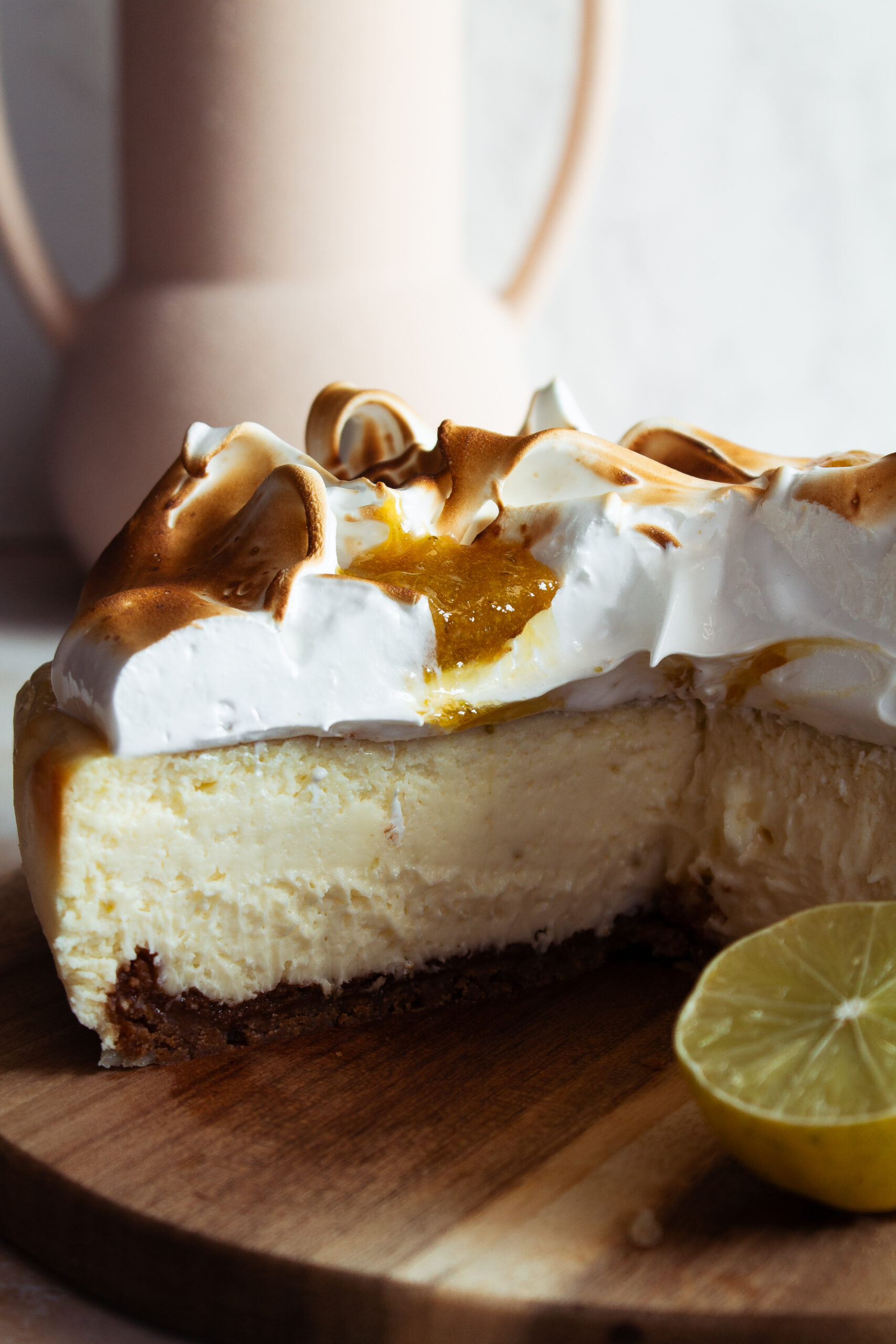
How to make meringue?
The meringue topping balances the flavors and textures of this toasted lime cheesecake so well. To make it, simply use the egg whites from the same eggs you used for the lime curd, then add the sugar and place the two in a banne marie. Warm the egg whites and sugar to roughly 160F or until you can’t feel any granules of sugar between your fingers anymore. Then whip until it reaches stiff peaks. Then top the cheesecake and toast the meringue with a blow torch for maximum flavor and visual appeal!
How to cool cheesecake?
Arguably the most annoying part of making this classic cheesecake is the patience it requires. I always recommend making your cheesecake the night before you want it so that it has time to cool completely in the fridge. Here are the steps I take to allow my classic cheesecake to come up to room temperature slowly, a process that will help you avoid cracks and give you the best creamy texture!
- After the cheesecake has completed baking, turn the oven off and crack open the door of the oven for one hour.
- After the hour of cooling in the oven, remove the cheesecake and set it on the counter for at least 1 hour. The goal here is for the pan to no longer feel warm to the touch so this could take longer than 1 hour.
- Cover the cheesecake and refrigerate it for at least 3 hours or preferably, overnight!
I know the process is tedious but it really helps to not shock the cheesecake with a cooler temperature. We baked it slowly and now we must cool it slowly.
A note on cheesecake pans
One thing about cheesecake is that it can’t be made in a regular cake pan. You will need a springform pan to be able to easily pop out the cheesecake when it’s time to serve it. I a 7” springform pan for my classic cheesecake recipe.
Pro Tip: Place the pan on top of a baking sheet when baking the graham cracker crust and the cheesecake, just in case the butter leaks through, the pan will catch it before it hits the bottom of the oven!
Top the cheesecake with your favorite fruit, fruit sauce or jam like my 10 minute strawberry sauce or my lemon curd and enjoy!
STILL CAN’T GET ENOUGH CHEESECAKE?
Try my other cheesecake recipes:
- Peach Cobbler Cheesecake
- Cookies and Cream Cheesecake
- Crème Brûlée Cheesecake
- Salted Caramel Cheesecake
Can baking be therapeutic?
I often talk about baking being a therapeutic hobby but I’d like to share more about why I feel that way as well as how it can become a relaxing hobby for you! When I bake, it’s my creative time. I may put on my favorite nostalgic movie or tv show in the background, or a Spotify playlist titled “French café” and leave my troubles behind.
Sometimes I pour myself a glass of wine and light a candle. Then, with the mood set, the mixing of batter, kneading of dough and smoothing of icing is my only care in the world.
When I say baking is therapeutic, sometimes people respond saying “not for me it isn’t!” I completely understand why someone might feel that way. There have been plenty of times where I spend hours on something only for it to fail or something breaks that shouldn’t or I forget to clean as I go and am left with a disastrous kitchen to clean.
So I should in reality, have a caveat to my “baking as therapy” claims…
Baking is therapy when you curate the experience to be relaxing.
How do you curate that relaxing experience for yourself, you ask?
How to make baking therapeutic…
- Prepare your mind–know that it’s okay if the cake doesn’t rise, or the butter wasn’t chilled enough. Shift your mindset from seeing your failures as mistakes to seeing them as opportunities for learning.
- Prepare your space–I cannot and will not bake on top of a messy kitchen. If I were to do this I would be starting from a place of stress! Take an extra 10 minutes to clean any dishes in the sink and wipe down the counters, this small effort will pay you back greatly in brain space and clarity.
- Clean as you go! I’ll tell you the one way to make baking stressful and tiresome, is to not clean as you go! After I use each ingredient that I no longer need, I put it away.
After each major step in the process, I wipe down the counters and put dishes that are no longer needed in the sink. If there is chill time or baking time I don’t sit, I do the cleaning then. Make this shift and you’ll really notice the difference!
By the way, this last tip really helped me when I was on The Great American Baking Show–and the crew that cleaned up behind us made a point to tell me that my workspace was always so clean they didn’t have much to do!
I would reply by saying “it’s how I stay sane in this tent!”
Additional suggestions:
*Maybe try printing off the recipe instead of looking at it on your phone, tablet or laptop and use this time to unplug from technology for a few hours.
**Invite friends or family over to share your baking creation with you. Time spent with loved ones over food is a universally special experience!
That’s how I discovered baking for my mental health. If you try any of these suggestions, let me know how it went for you! I’m really invested in spreading this message to others in hopes that baking will enhance your lives more than it already does!
Happy Cheesecaking!

Toasted Lime Cheesecake
Equipment
- 7" springform pan
- food processor/blender
Ingredients
For the Biscoff Cookie Crust
- 1/2 package (135g) biscoff cookies blitzed into crumbs
- 1/4 cup (55g) unsalted butter melted
- 1 Tbsp (12g) granulated sugar
For the Lime Cheesecake
- 24 oz (675g) (3 blocks) full fat cream cheese room temperature
- 1 cup (200g) granulated sugar
- 1 Tbsp cornstarch
- 2 tsp lime zest
- 1/4 cup (30g) lime juice
- 3 (150-155) large eggs room temperature
- 1/2 cup (130g) sour cream room temperature
For the Lime Curd
- 3 (45-50g) large egg yolks
- 1/2 cup (100g) granulated sugar
- 1 Tbsp (5g) lime zest
- 1/4 cup (60ml) lime juice
For the Meringue Topping
- 3 (120g) large egg whites
- 1 cup (200g) granulated sugar
Instructions
For the Biscoff Cookie Crust
- Preheat the oven to 350°F (roughly 180°C) and line a 7" springform pan with parchment paper.
- In a blender or food processor, blitz 1/2 package (about 135g) of biscoff cookies into crumbs.
- Add 1/4 cup (55g) of melted butter and 1 Tbsp of granulated sugar (12g) to the biscoff cookie crumbs and mix until combined.
- Add the mixture to the lined springform pan and press it into the bottom of the pan.
- Bake the biscoff cookie crust for 8-10 minutes and then remove from the oven to cool.
For the Lime Cheesecake
- Reduce the oven temperature to 325°F (roughly 160°C) and bring a pot of water or kettle or a boil.
- To a medium bowl, add 24oz (675g) (3 blocks) of full fat cream cheese at room temperature. Use a hand mixer to break down the cream cheese slightly.
- Add 1 cup (200g) of granulated sugar, 2 tsp of lime zest and 1 Tbsp of cornstarch and cream until combined. Do your best to not add too much air into the cheesecake batter, just mix until well combined.
- Add in 3 large room temperature eggs (150-155g), one at a time, and mix until combined. Then add 2 tsp of vanilla bean paste (or vanilla extract) and 1/4 cup of fresh lime juice and mix until incorporated.
- Switch to a spatula and stir in 3/4 cup (195g) of room temperature sour cream until everything is evenly mixed in.
- Add all of the cheesecake batter to the springform pan with the cooled biscoff cookie crust and spread evenly. Pour the boiling water into the pan at the bottom of the oven. Then place the cheesecake on the rack directly above the pan with the hot water. Remember to place the cheesecake on a tray to avoid leakage.
- Bake at 325°F (160°C) for 45-50 minutes depending on your oven. For my oven about 50 minutes works perfectly. You're looking for a slightly wobbly center and a top that is barely browned. The wobble will settle as the cheesecake cools, leaving you the perfect texture in the end.
- When the cheesecake is done baking, turn the oven off and leave the cheesecake in the oven with the door of the oven slightly open for 1 hour. This helps the cheesecake cool down slowly, instead of shocking its temperature, potentially leading to splits.
- Once the cheesecake has cooled in the oven for 1 hour, remove it from the oven, place it on the counter and allow it to come close to room temperature for another hour or so. Then cover it and place it in the refrigerator to chill for 5 hours or, preferably, overnight
- While the cheesecake chills, make the lime curd.
For the Lime Curd
- Add 1/2 c granulated sugar and 1 Tbsp lime zest to a small/medium saucepan that is off the heat. Give the mixture a vigorous whisk.
- Add 3 large egg yolks to the saucepan and give the mixture another vigorous whisk until the mix has lightened in color. Reserve the egg whites to make the meringue topping.
- Pour in 1/4 c fresh lime juice and whisk until combined.
- Place the saucepan over low/medium heat making sure to whisk constantly. Pay special attention to the edges of the saucepan, the curd would most likely burn here if anywhere.
- Whisk constantly until the mix thickens. You’ll know it’s done when it reaches a hollandaise sauce consistency. It will thicken even more in the refrigerator.
- Chill in the fridge until completely cooled.
For the Meringue Topping
- Right before assembling the cheesecake, make the meringue by adding the 3 egg whites (roughly 120g) and 1 cup (200g) of granulated sugar to the bowl of a stand mixer.
- Place a small pot with about 1 inch of water on the stove and bring it to a simmer.
- Place the bowl with the sugar and egg whites over the pot so that the bowl gets gently heated but doesn't actually touch the water.
- Whisk the egg whites and sugar constantly until the mixture reaches 160°F or until you can rub a bit between your fingers and you no longer feel any graininess from the sugar.
- Remove the bowl from the heat and whip it until stiff peaks form.
For the Assembly
- When the cheesecake has fully cooled, top it with the cooled lime curd and spread the curd evenly. Optionally, reserve a small amount of lime curd to add a few dollops to the top of the meringue in the end.
- Add the meringue on top of the lime curd and create divots in the meringue with your spatula.
- Toast the meringue using a handheld torch.
- Add the remaining lime curd to the divots in the meringue, serve and enjoy!!
- This lime cheesecake will last in the refrigerator for up to 5 days!
